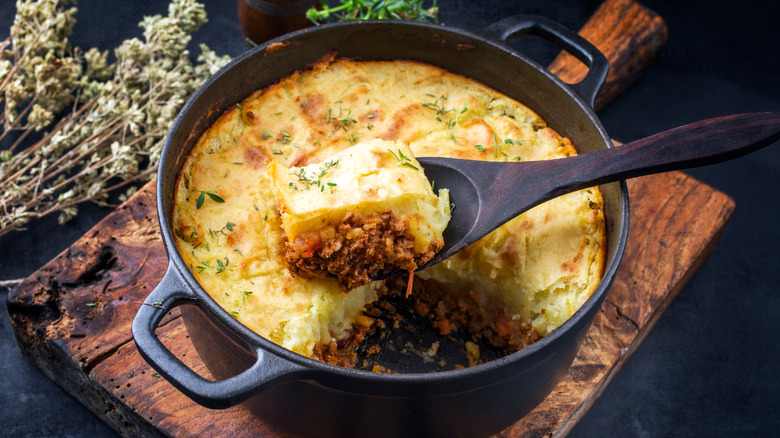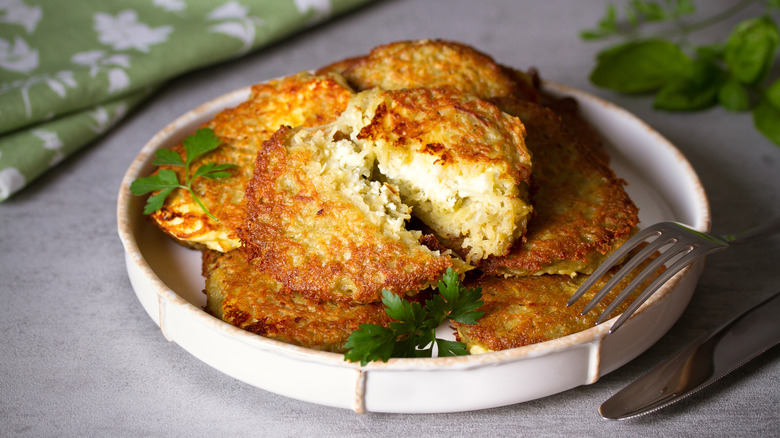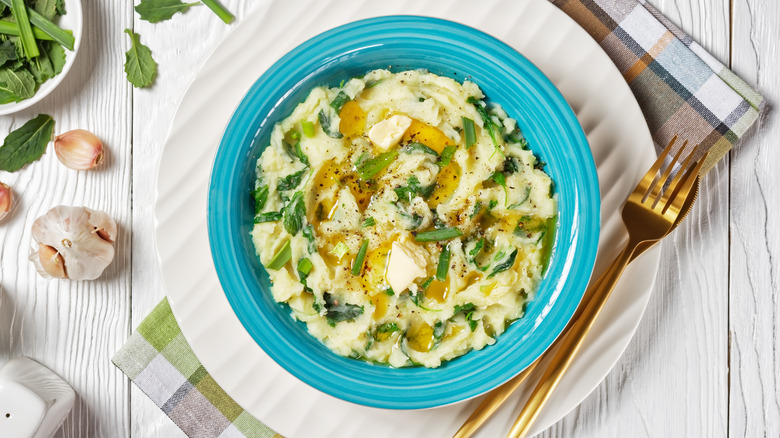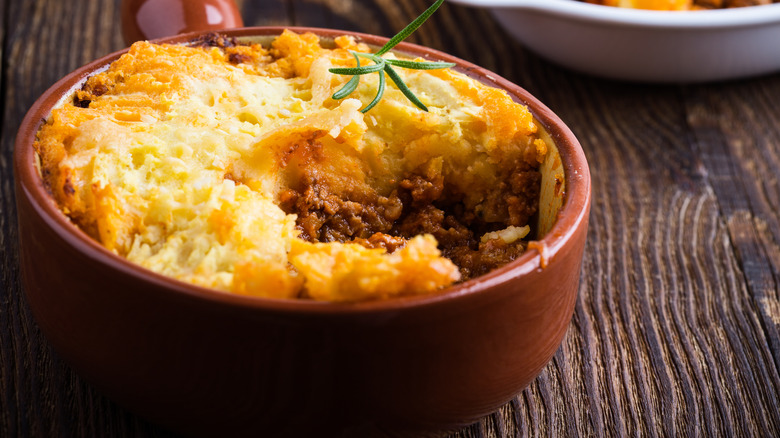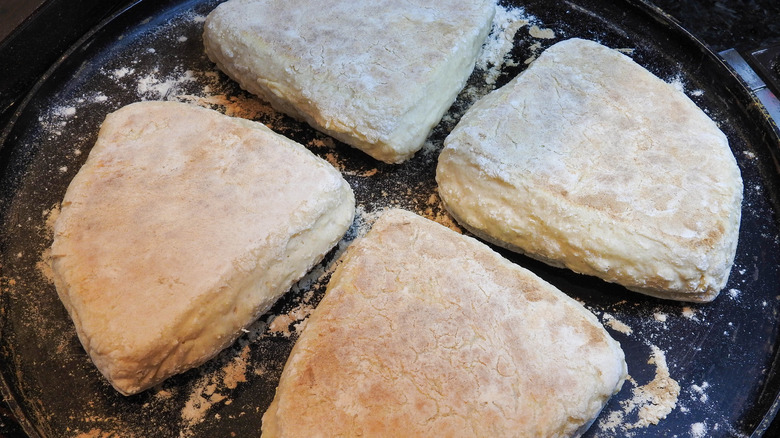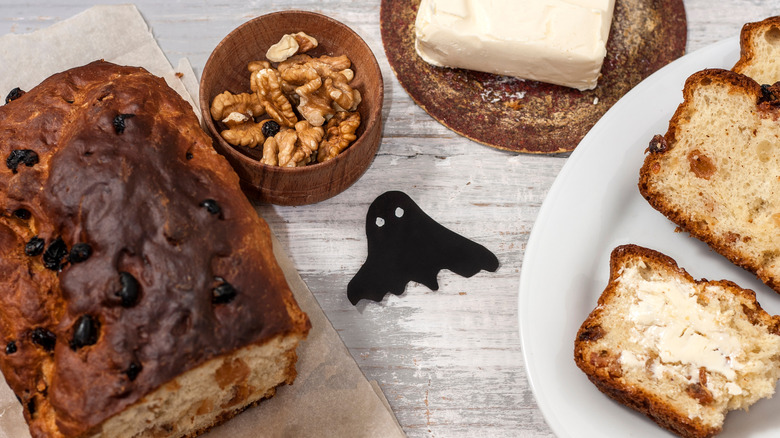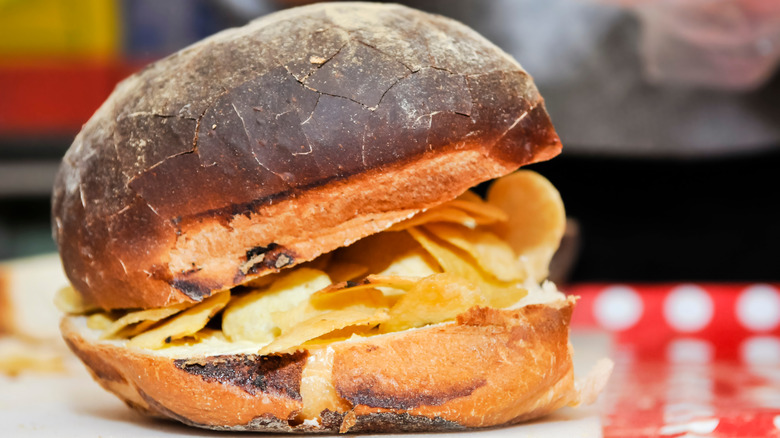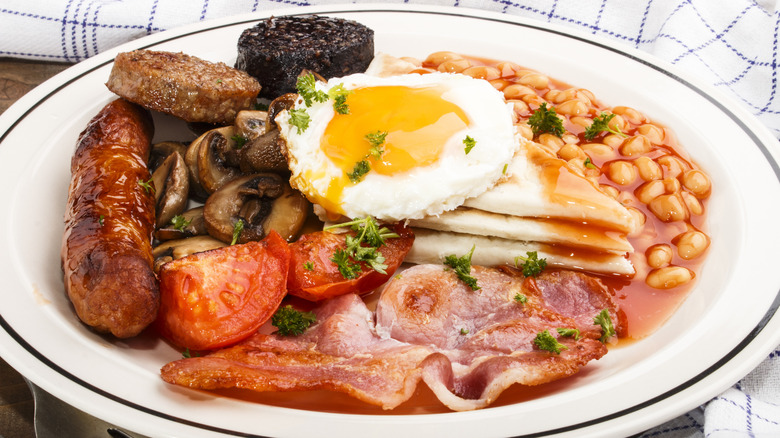13 Popular Irish Foods Explained
Looking past the picturesque green mountains and lush landscapes, Ireland is more than just a pretty face; it has a rich cultural history as well. Ireland has been inhabited since 8000 B.C. (via Irish Central), and in that time, the food has evolved dramatically. While Americans may think of Irish fare as simply Guinness beer and corned beef and cabbage, mainstays for the American celebration of St. Patrick's Day, there's so much more than that.
Of course, beer has its place, and potatoes show up, but Irish cuisine offers a vast range of dishes often forgotten by outsiders. If you've heard of different Irish foods and aren't quite sure what they are, do not fret. We've compiled a list of 13 popular Irish foods, which we will explain to help you better understand this facet of Irish culture. Have you ever wondered what black and white pudding really is or the difference between shepherd's and cottage pie? Well, read on, and all shall be explained.
1. Bangers and mash
To understand bangers and mash, you must first know that the phrase refers to the two components of the dish. "Bangers" are sausages. According to Britannica, sausages began to be called "bangers" during World War I. The shortage of meat caused by the war led to additional fillers being used to make sausages. Unfortunately, one of these fillers was water, which caused them to burst during cooking and create a "bang." Other sources, such as Donald Russell, attribute bangers to the Second World War, but the explanation of a meat shortage and resultant exploding sausage is the same. The meat component of bangers can be beef, pork, or lamb.
The second component is a bit more conventional in its name: "Mash" is a shortened version of mashed potatoes. Put it together, and you have sausages and mashed potatoes. Typically, the whole thing is then served with onion gravy. This creates a meal that has a protein and a carb and is relatively easy to create and serve. As a result, bangers and mash is particularly popular in bars.
2. Boxty
This list would not be complete without boxty. Boxties are, at their core, Irish potato pancakes. Despite being one of the first foods people think of when they think about Ireland, potatoes did not originate there; instead, they were brought back from South America during the 1500s (via Culture Trip). However, this has not stopped them from becoming an integral part of the country's diet.
And what is more natural to do with something than to fry it? Lots of cultures have their version of the fried potato pancake, from the Jewish latke to the Korean gamja-jeon. The Irish version is typically made from grated potato, flour, baking soda, and buttermilk. It is often fried, although Culture Trip notes that it can also be baked or boiled. Whatever your preference, the end result is a somewhat pillowy potato dish that offers a bit more of a bready consistency than a hash brown and, if fried, has a nice, crispy outside.
So why is it called boxty? "Boxty" is thought to be a shortened version of "arán bocht tí," which means "poorhouse bread."
3. Champ and colcannon
We are riding this Irish potato train and introducing another popular Irish dish, this time in the form of mashed potato dishes, specifically champ and colcannon. We have decided to put these two together because of their incredibly similar appearance and taste, as noted by M Food.
Champ is made from potatoes that have been mashed with milk and butter, creating a creamy, luxurious mix. Scallions are then added in. As M Food explains, the dish is usually left simple and unadorned with complicated ingredients. One tradition involving the dish says to wrap a coin in paper and hide it in the champ, and the person that finds it will have great luck.
Colcannon is also found in Ireland, but it's instead made from mashed potatoes mixed with cabbage rather than scallions (via Smithsonian Magazine). Colcannon is made as a dish for Halloween. Similar to champ, a coin, rag, or stick object would be hidden in the dish, and depending on what the eater found, a different thing would happen to you. A coin was money, a rag indicated poverty, and a stick meant a beating.
While obviously, the predictions could be a mixed bag, either of these dishes provides a filling and easy-to-make meal with cheap ingredients, which has helped keep them popular and enjoyed through the years.
4. Coddle
Coddle is a dish that is hard to pin down because the whole point of it is to use up whatever you have on hand. According to the Dublin City Council website, coddle is a stew made from leftovers and pantry staples. This can include root vegetables such as potatoes and onions and meats such as sausages and rashers, which are thin-cut bacon. Coddle started as a dish during a famine in the 1700s, brought on by intense cold and lack of rain. This led to bad grain and milk harvests. In order to avoid waste, and use what they had available, people made large pots of coddle. Root vegetables and sausage were both easier to obtain than other items and could be combined to make a hearty meal. Coddle could be made the day before and allowed to sit so there would be food the next night.
The name is thought to come from the French word "caudle," which refers to boiling or stewing gently — an appropriate name for the dish. Coddle is incredibly flexible with what goes into it; though the Dublin City Council notes traditional coddle does not include carrots, we won't tell anyone if some slip into your next batch.
5. Cottage pie
There are so many different kinds of pie out there, but we are going to focus on one that is not what we typically think of as pie: cottage pie. Unlike the pies we tend to think of, which feature filling contained in pastry crusts and are often sweet, cottage pie is a savory meat-based dish topped with potatoes (via Thompson House).
Cottage pie and its cousin, shepherd's pie, originated across the water in Scotland before quickly making their way over to Ireland, where they became fan favorites (via MasterClass). The first use of the term "cottage pie" comes from 1791, which was around the same time that potatoes became popular (via Thompson House). Both cottage and shepherd's pie feature a mixture of meat and vegetables in the base and are topped with potatoes. The only difference is that shepherd's pie is usually made with lamb, while cottage pie is made with beef. However, this distinction came much later in the 1900s. The dish is delicious and makes for a hearty and warm meal.
6. Farl
Many of us think of soda bread as a big loaf of bread for slicing, but in Ireland, there is another kind of soda bread — farl. Instead of being baked in an oven, farl is made on a flat griddle. This was traditionally done on a griddle suspended over an open flame but can be done on more modern-day griddles as well. The bread is made from a mix of Irish soft wheat, baking soda, and buttermilk. Additionally, the Cambridge Dictionary notes that oats and potatoes may also be used to make farl, along with potato flour. This created an incredibly soft soda bread that had an almost cake-like texture. Farl does not rise as high as oven-baked soda bread. Additionally, while soda bread is more common in the southern part of Ireland, farl is more common in Northern Ireland.
The name "farl" comes from the Gaelic word "fardel," which translates to "four parts" and refers to the four triangular pieces the bread is typically cut into. Today, farl is eaten as part of an Ulster fry.
7. Soda bread
Traditional soda bread is more like the loaf of bread we would typically think of. The main difference between it and farl is that baking powder is used as a chemical leavener instead of yeast.
According to The Society for the Preservation of Irish Soda Bread, the first recorded Irish soda bread recipe dates back to 1836. Its rise in popularity was due to a combination of things. First, during what is commonly known as the Irish Potato Famine from 1845 to 1852, a potato blight destroyed a huge source of food throughout the country. Another factor was the introduction of commercial baking soda in 1846 (via Smithsonian Magazine). Prior to this, pearl ash was used. The third is that Irish wheat tends to be softer than American wheat. This means that while American wheat made better yeast-raised bread, Irish wheat made excellent soda-raised bread.
To help feed the masses and use the resources they had, baking soda was used in combination with an acid such as buttermilk to give rise to bread. This made a hearty quick bread that has become intrinsically linked with Ireland.
8. Black and white pudding
Despite its name, this dish is not a dessert. Instead, black and white puddings are two different kinds of sausage (via MasterClass). Though they are often lumped together, these sausages have some distinct differences.
White pudding is an oatmeal sausage. This means that in addition to the meat and animal fat used to make the protein portion, ingredients like oatmeal give it a whiter appearance than other sausages. The mix may also include bread crumbs and spices. White pudding was created as a way to use up leftover animal organs. On the other hand, black pudding contains blood, which gives it a darker color. The inclusion of blood can also give the black pudding a bit of a metallic taste (via MasterClass).
While black and white puddings are found beyond the Emerald Isle, Irish varieties can include pork, additional spices, and sometimes potato flour and are used as part of the Irish breakfast.
9. Barmbrack
In addition to colcannon, barmbrack is a traditional Irish Halloween food. Barmbrack is a sweet bread with pieces of dried fruit mixed in (via the Irish Independent). Tea and whiskey can also be used to soak the fruit when making this bread. The Gaelic name for the bread is "bairín breac," which translates to "speckled bread," a way to describe the look of the bread.
Barmbrack is eaten year-round, according to the Irish Independent. However, it has particular significance on Halloween. Similar to colcannon and champ, objects are hidden in the bread, which, when found by someone, are said to tell your fortune. A coin symbolizes wealth, and a ring can mean marriage, whereas a pea means you will not be getting married. However, this tradition died down in commercial bakeries due to the risk of liability. Still, Barmbrack remains a popular Irish dish with or without the objects hidden inside.
10. Pastie supper
You may have heard of pasties, which are found all over the United Kingdom and Ireland. A pasty is a pastry crust that has been filled and folded onto itself, similar to an empanada. It typically contains meat and potatoes and occasionally has gravy served on top. The dish we're talking about here, however, is an Irish pastie. (And yes, it's spelled "pastie" as opposed to "pasty.")
In Northern Ireland, there is a dish called a "pastie supper," and these pasties are prepared quite differently from the ones you'd encounter in England: According to Don't Stop Living, a patty of minced pork, onion, potato, and more is deep-fried. The pastie is then paired with chips (also known as "fries" for us Americans) to create a delicious fried heaven. This meal is eaten, unsurprisingly, for dinner. The fried pastie is a popular Irish food that has long-running ties to the country.
11. Gur cake
What's in a name? That which we call a cake would by any other name still taste as sweet. We're sure Shakespeare said something like that. Anyway, the cake we're talking about goes by many names. In Dublin, it is called a gur cake; it can also be called Chester cake or donkey's gudge (via Cork Slang). All this describes a unique cake made from bakery leftovers sandwiched between shortbread pastries.
As with many of the foods on this list, it comes from a way of avoiding throwing away even the most inedible of scraps. Stale baked goods or scraps are mixed with a liquid, such as tea, to create a malleable filling. This is then baked between the two pieces of shortbread to create a whole new dessert.
The name "gur cake" comes from the Dublin slang for poor, young troublemakers on the street known as "gurriers." The flavor of the cake can vary depending on what ingredients are used and if dried fruit is added. No matter the additions, it will still be a delicious treat that helps minimize any food waste.
12. Belfast bap
The Belfast bap is named after the city of Belfast in Ireland. Functionally, a bap is a large roll, and "Belfast bap" can refer to two things. The first is the roll itself, which was created by Bernard "Barney" Hughes (via BBC News). Hughes was an Irish businessman and the owner of the largest bakery in Ireland. When the Irish Potato Famine hit, he created a small bread loaf that he sold at a reasonable price. This became known as the Belfast bap. The Belfast bap is still popular today, with supermarkets such as Sainsbury's continuing to sell them at reasonable prices.
Belfast baps can be used much in the same way as a burger bun, which brings us to the second use of the term. As Guide Ireland notes, another meaning for a Belfast bap is a traditional Irish breakfast, all mashed between a beautiful bap. Is it a lot? Yes. Does it sound delicious? Also yes. This is basically the breakfast sandwich to end all breakfast sandwiches. They can be found in bars and restaurants in Belfast.
13. Ulster Fry
You have to start a day off right, and what is better than starting it with breakfast? To quote Leslie Knope of "Parks and Recreation," "Why would anyone eat anything other than breakfast food?" Since we are talking about Irish food, it is impossible not for us to talk about Irish breakfasts. A full Irish breakfast and an Ulster fry start off the same way, according to Culture Trip. They both contain bacon, eggs, and sausage — all fried, of course. An Ulster fry, named for the Ulster province of Ireland, may also contain farls, either in potato form or pure wheat form. Vagabond also notes that sometimes a boxty can be used in place of potato farls.
While Culture Trip identifies additional items such as tomatoes or mushrooms as extra but not traditional, Vagabond claims that they are an essential part of the Irish breakfast. Whatever your preference, for a conventional Ulster fry or for a jazzed-up version, you will not be leaving the table hungry.
